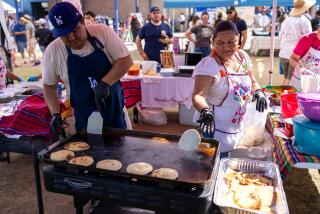Not just to praise Cesar
Two years ago, a presidential contender touting his roots as a community organizer endorsed the idea of a national holiday to honor a legendary organizer.
âAs farmworkers and laborers across America continue to struggle for fair treatment and fair wages, we find strength in what Cesar Chavez accomplished so many years ago,â said Barack Obama, then on the verge of his own improbable victory. âItâs time to recognize the contributions of this American icon.â
An icon, according to Websterâs, is âan object of uncritical devotion.â And thatâs precisely the problem: Cesar Chavez has been elevated to iconic status, his name reverently placed on schools, streets and postage stamps, without his legacy having been critically examined.
Chavez merits an important place in the history books, as a civil rights leader, an inspiration for a generation of Chicanos and the founder of a movement that transformed thousands of lives. But the history is more complex than the hagiography, and more enlightening. His birthday, March 31, should be an occasion to educate new generations about Chavezâs remarkable accomplishments, and to learn from his life in all its complexity and contradictions.
Chavez masterminded a grape boycott in which uneducated farmworkers fanned out across the country, persuaded millions of consumers to shun the fruit and forced growers to sign the first-ever labor contracts. Then he doomed the contracts by administering them poorly.
He taught workers how to exert power, then fired leaders who rose up from the fields to use their newfound power.
He brought the men and women who pick our fruits and vegetables into the public consciousness for the first time, then squandered that legacy for future generations.
The first half of the story has been widely told and Chavezâs place in history justly celebrated. His birthday is already a holiday in California and several other states. But the David-versus-Goliath victories are only a piece of the Chavez story.
Chief among the lessons we should take from his life is that heroes are human, with real flaws. You follow them blindly at your own risk. The biggest regret that many who worked closely with Chavez now express is that they did not speak up for what they believed in when it might have mattered. They failed to fight to keep building a labor union when Chavez veered determinedly toward his vision of a communal movement for poor people, based on an ideology of sacrifice.
A second lesson is that the inspirational leaders who build movements are not necessarily suited to run organizations. Chavez was a brilliant strategist, most comfortable in the adversarial role he termed the ânonviolent Viet Cong.â By contrast, he dismissed as ânonmissionary workâ the day-to-day routine of administering a labor union, negotiating contracts and resolving grievances. He lacked the interest to focus on those more mundane issues -- or the will to delegate the work to others and relinquish control.
His insistence on absolute control demonstrates a third lesson: When you empower people, they may not choose to wield their power toward the goals you believe they should. Chavez was a risk-taker, and he taught others to take risks. But trusting workers to run their own union was one risk he adamantly refused to take. That cost farmworkers the best chance they ever had at building an effective and lasting union.
None of this appears in Californiaâs official curriculum, a selective and glowing account of Chavezâs life, developed in conjunction with his heirs and adopted by the state Board of Education to fulfill the law that established Cesar Chavez Day.
Today, the union he founded, the United Farm Workers, represents no more than a few thousand farmworkers. Four decades after it triumphantly signed contracts, conditions and wages for many in the fields are as bad as ever.
Olga Ramirez confronts that fallout from the Chavez era every day. Ramirez arrived in California in 1994, a few months after Cesar Chavez died. She was 9 and spoke no English. Today she teaches first-graders at Chualar Elementary School, in a classroom that borders the Salinas Valley fields where most of their parents work. She brings newspapers and magazines to class, to show children who have never seen them. She attends meetings where parents learn how to read their pay stubs, so they can figure out if employers are cheating on overtime.
She arrives at school before dawn some days and stays past dark, to accommodate parents who passionately hope that education will offer their children a path out of the fields. Until she visited her studentsâ homes in Camp 21, Ramirez would not have believed that people still lived in such squalid, overcrowded housing.
She would like her students to learn about Chavez and appreciate what he accomplished. But she also wants them to learn that the story did not have a fairy-tale ending.
For her students, Cesar Chavez Day means no more than a day off from school. For their parents it means even less; they will be at work, in the fields, invisible once again. That too is part of Chavezâs legacy. Itâs long past time to honor the man and not the myth.
Miriam Pawel is the author of âThe Union of Their Dreams -- Power, Hope, and Struggle in Cesar Chavezâs Farm Worker Movement.â
More to Read
Sign up for Essential California
The most important California stories and recommendations in your inbox every morning.
You may occasionally receive promotional content from the Los Angeles Times.










